Heating element for Bosch dishwasher: how to choose + replacement instructions
According to statistics, dishwashers from the German manufacturer Bosch are used today by about 30% of owners of this practical and reliable kitchen equipment. But sometimes owners are faced with the problem of supplying hot water.
The indicator gives a signal that the heating element for the Bosch dishwasher has become unusable, which means it needs to be urgently replaced with a working one. But how to do it correctly and how to choose a new one? We will talk about all this in detail in our article. We will also provide detailed instructions on how to independently replace a broken heating element with a new one.
The content of the article:
What indicates a breakdown of the heating element?
Almost all modifications of modern dishwashers have in their designs a complex of complex mechanical and electronic “stuffing”, ranging from a system of water supply and drainage pipelines with pumps, ending with a digital control unit.
The programs in the devices are also varied in their functions.
If an error code appears on the dishwasher control panel “09”, “E09”, "F09", then this will mean the presence of a serious problem with water heating in the unit.
Most likely, a damaged heating element, also known as a tubular heating element, is to blame for this, and other elements of complex equipment may also be affected.
Have you seen a different error code on your dishwasher display? Do not despair! We recommend that you read decoding error codes Bosch brand dishwashers so that you can determine the cause of the malfunction.
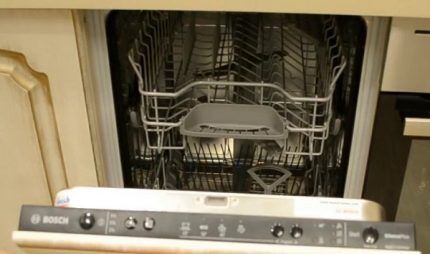
Problems with water heating can also be caused by the following troubles:
- short circuit in the power supply circuit residential premises;
- emergency oxidation of contactslocated on the terminals of the heating device;
- excessively hard water, entering the machine from the water supply.
In such cases, owners need to decide to replace the electric heating unit themselves or invite a service specialist.
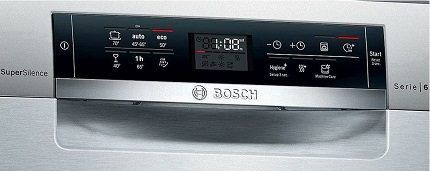
It is not for nothing that heating elements are considered the heart of PMM of any configuration, regardless of the popularity of the brand and “sophisticated” functions. The use of dishwashers in domestic conditions proves this.
After all, damage to heating elements brought to a critical level can in 100% of cases render the entire complex mechanism of the machine unusable. Why expose such an expensive thing to unjustified risk?

Abnormal (incorrect) operation of heating elements in dishwashers is a dangerous prerequisite for more serious negative consequences both in the subsequent operation of the device and in the lives of people who directly use the equipment.
That is why it is so important to try to quickly get rid of problems and breakdowns in your favorite assistant machine!
Water heater device
The electric heater installed in the body of the dishwasher belongs to the category of water heating elements, providing stable heating of circulating water up to +100 °C. Some models may be equipped with thermostats.
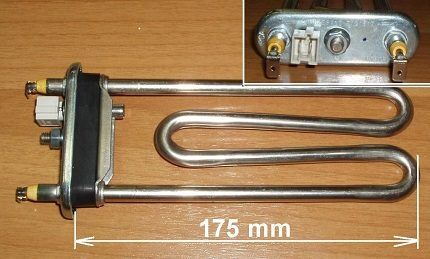
The tubular heating element contains an electrically conductive spiral, which transmits the design power to the entire outer surface of the heating module.
The main components of the heating element include:
- a tube;
- heating element;
- contacts;
- insulating layer.
The thermoelectric segment of the heating element is available in a variety of designs. There are practically no disadvantages in the devices, except for the large area for installation and the need for repairs if the spiral burns out.
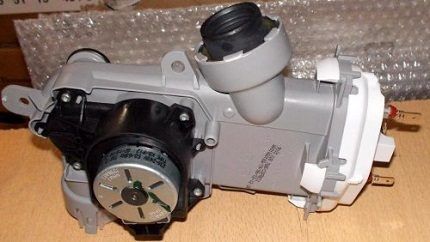
Electric heaters for dishwashers with a tubular design are produced by industry with the following parameters:
- power — 15 W-15 kW;
- voltage — 12 V-380 V;
- length — 250-630 mm;
- outer diameter - 6.0-24.0 mm.
If you have a 3rd generation Bosch machine, then it contains an improved pumping motor with a heating element built into it.
Causes of breakdowns and subtleties of choice
Problems with one of the main structural elements of the dishwasher can occur for various reasons. We invite you to take a closer look at possible problems, and also provide a number of tips for choosing a new TEN.
Why might TEN break?
According to user reviews, the most common failures of the electric heater in a dishwasher are burnt out spiral threads and electrical shorts at the tube terminals.
Burnout is a direct consequence of thinning of the refractory element located in the hermetically sealed heater.
Flow-through heating elements in dishwashers often burn out.
This may happen if:
- there is a leak in the heating element;
- there was a sharp surge in voltage in the power supply network (if such surges are a common occurrence, then it would not be a bad idea to purchase and install stabilizer);
- the filter is very dirty;
- the machine is not being used correctly (it is advisable to familiarize yourself with Dishwasher operating instructions);
- wear, accumulation of a significant layer of scale on the heating element (if the layer thickness exceeds 2-3 mm, then failure of the element is inevitable).
With such serious breakdowns, there is nothing left to do but replace the burnt element with a new one. But before that you have to buy it, choosing the right one - any model will not work.In this matter, a number of features must be taken into account, which we will discuss below.
The nuances of choosing a new heating element
When ordering a spare part from online or service stores to replace it yourself, you must provide complete information about the model, including the serial number. The information is on the machine's label. We provide detailed recommendations on finding and selecting quality spare parts for dishwashers. brought here.
Also, when choosing a heating element, it is important to pay attention to its technical characteristics: carefully check its general purpose, power and voltage parameters, diameter similar to the factory ones, as well as compliance of the device with a standard connector for connection.
We advise you to pay attention to maintaining tightness at the output ends of the purchased device.
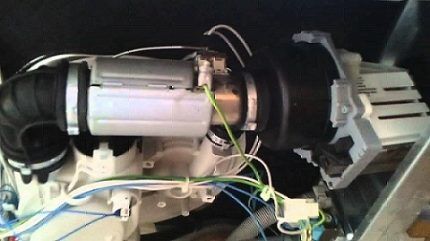
Electric flow heaters heat quickly, but consume a lot of electricity. We recommend taking this into account: if you have a dishwasher and an electric kettle running at the same time, the plugs may fly out and the machine will turn off the power to the entire apartment.
Electric thermal heaters intended for installation in BOSCH dishwashers are available in the following designs:
- submersible (wet) - contact with the working liquid medium, heating it;
- dry — surrounded for protection by a special flask made of durable composite material steatite.
Dry heaters are considered by professional craftsmen to be more effective in practice, because by eliminating direct contact with liquid they can last a very long time.
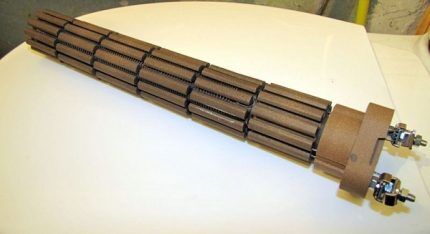
In various modifications of Bosch dishwashers, sensors for the distribution of water flows, water turbidity and an electric relay can be installed on heating elements, which is switched by a membrane moving under water pressure.
For Bosch dishwashers, heating elements are sold that are included with the pump. This is one single piece, so it is considered non-separable. Its cost is quite high and can vary in a wide price range: from 7,000 to 11,000 rubles.
Step-by-step instructions for replacing the heating element
Have you decided to replace a faulty heating element in your dishwasher yourself?
Prepare the following set of necessary tools:
- 2 screwdrivers – flat and Phillips;
- screwdriver;
- multimeter or ohmmeter;
- pliers and awl.
The algorithm for independently replacing an electric heating element is as follows.
Step No. 1 - checking the new TEN
Check the serviceability of the new heater on a measuring device: the resistance reading should not be higher than 20-30 Ohms.
If it is more, then there is a break in the spiral; if the resistance is normal, then the part can be safely installed to replace the damaged one.

Step No. 2 - dismantling the trays and lower rocker arm
Open the machine's hopper door and remove the dish trays, unplug the household appliance, and remove the hoses. Pull upward to remove the plastic spray arm and stainless steel mesh filter cup.
Now you need to remove the lower rocker arm: to do this, simply grab the part and lift it up.
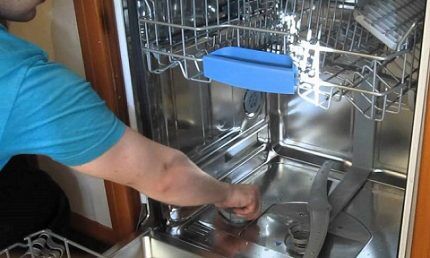
Step No. 3 - removing the pipe and rear panel
Release the pipe connected to the heating element - use a screwdriver or screwdriver to unscrew the 5 screws that support the pipe connected with clamps to the flow-through electric heater, then turn the housing over so that the bottom is on top.
Now remove the back panel. If the car has a retractable wall instead, then pull it out. The heating element is connected to the pump.
To disconnect it, grab it and turn it half a turn to the right, pull it to the side, then the pump will be in your hands. All that remains is to remove the sensor from it.
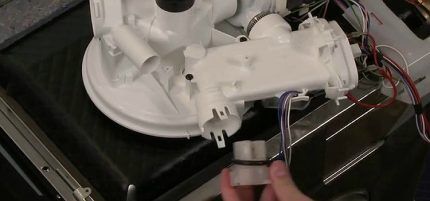
Step No. 4 - dismantling the burnt heating element
Remove the fasteners holding the heating element. In Bosch dishwashers, the heating elements are fixed from below with rubber fasteners. You need to put your hand under the body and disconnect them.
In the process, you will need to use an awl to pick up the plastic clamps holding the pipes. If you accidentally damage them, you can replace them with new ones, but it is better to act carefully.
Remove the burnt TEN. Disconnect the installation plugs of the sensors, pipes and remove the burnt and depressurized heating element.
If the pipes do not give in immediately, grab them with pliers, acting extremely carefully so as not to inadvertently damage the plastic parts: today their cost is quite high.
Step No. 5 - installation of a new heater-heater
Replacing the heater with a new one will not take much time. It is important to act extremely carefully, assembling all elements in the reverse order of the dismantling procedure. This replacement process can be clearly seen in the videos shown in the last block of the article.
We also recommend that you read installation and connection instructions Bosch brand dishwashers on your own, which will help you easily assemble the machine after repair and properly connect it to communications.
After installation, continue to monitor the performance of the heating element by regularly descaling it by mechanical cleaning or using chemical ingredients.
In addition to the TEN, other working components of the equipment require maintenance. Therefore, to extend the life of the dishwasher, it is advisable to regularly carry out its maintenance.
Conclusions and useful video on the topic
Video material from a professional technician working in the service department of the Bosch dishwasher manufacturer.
The sequence of replacing the heating element, a detailed explanation of the nuances of operation. Tips on the practical use of heating elements applicable to specific modifications of dishwashers.
The heating system of the heating element is located in the dishwasher at a close distance to other control units. Because of this fact, replacing it or the entire pump + heater unit seems like a troublesome and difficult task. But if you follow the instructions, the repair will be successful and safe.
The main condition for replacement is strict adherence to the sequence of dismantling the inoperative machine unit and care when installing a new element.
Are you planning to replace the heating element yourself, but still have questions about the process of removing the old one or installing a new heating element? Ask our experts in the block located below this article.
If you specialize in dishwasher repair and want to supplement our material with useful tips, please leave your comments on this publication.




Our dishwasher is a little over 5 years old. It worked well, considering how hard our water is, scale appears instantly. We also started getting error F09. I read it in the manual for the dishwasher, and it said heating element. I called a bunch of repairmen, and for all of them the repairs cost a pretty penny. And when I told my husband everything, he said that he would fix everything himself. We ordered the heating element online using the code, and it arrived exactly as needed. And replacing, as I understand it, is actually not very difficult.
There are a lot of errors in the article. In one of the photos there is a heating element for a WASHING MACHINE!!! To replace the heating element, there is no need to remove the rocker arm.... I didn't even read further.